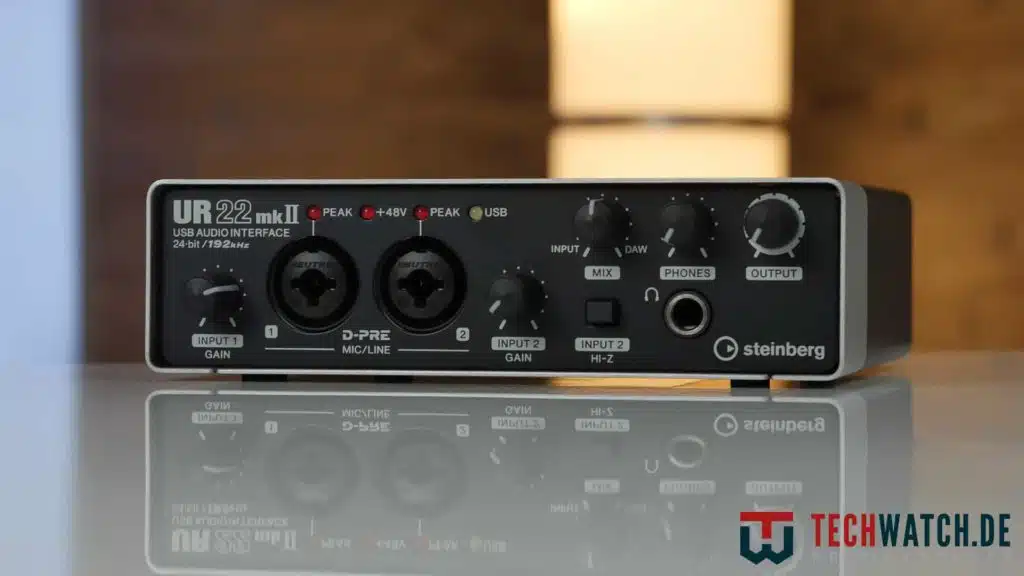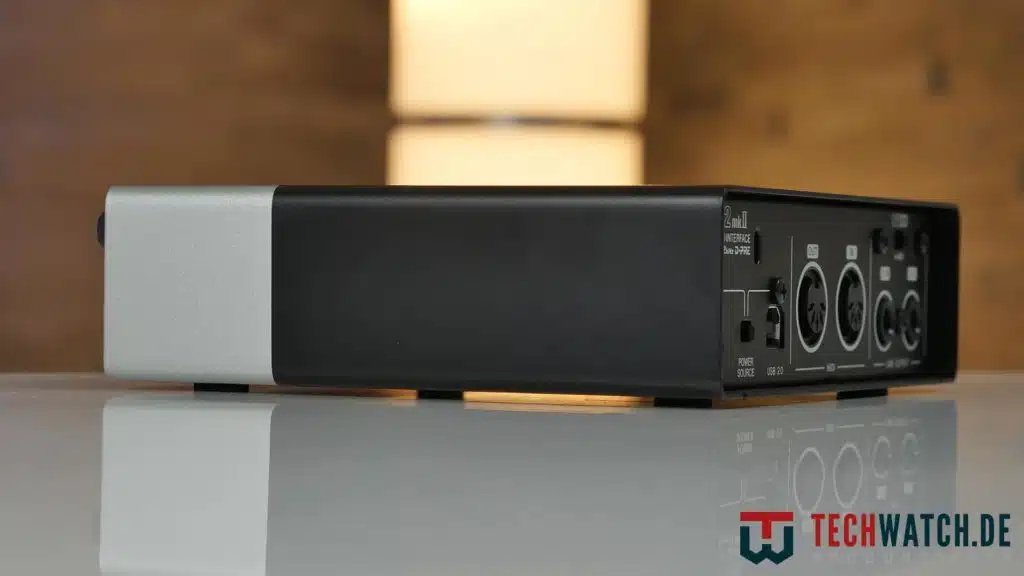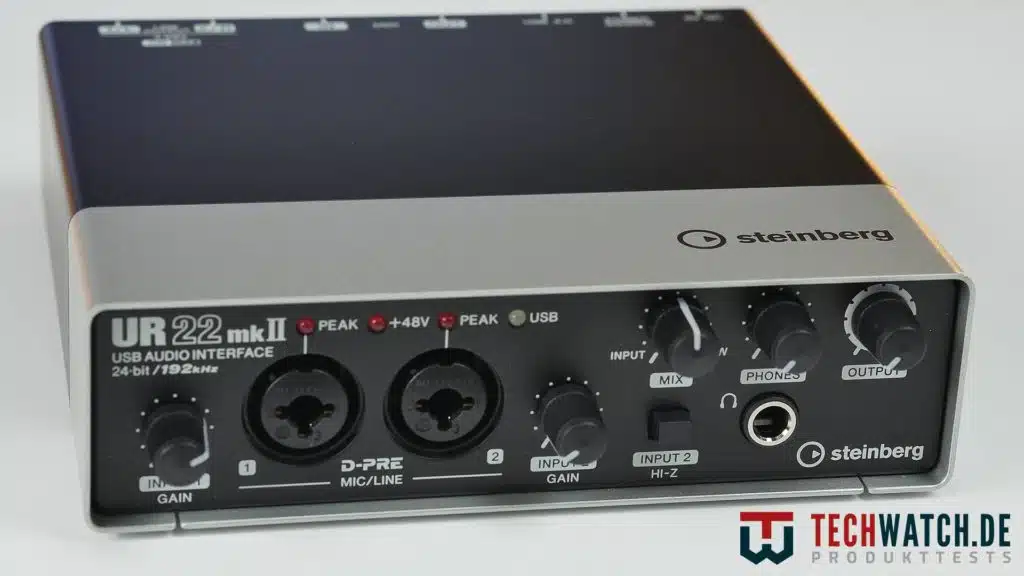The Steinberg UR22 MK2 USB Audio Interface from Steinberg is a successful all-round carefree package. While the sound quality more than satisfactory is, the workmanship of the device is also very good. The square audio interface appears in a serious two-tone look and was examined by us in terms of quality. The inexpensive Model convinces with a great performance across the board and makes the competition sit up and take notice.
The Steinberg UR22 MK2 is the almost perfect USB audio interface for around 100 euros. The high-quality processing, stable drivers and very good audio quality make the device our price-performance winner.
- 24-bit / 192 kHz USB 2.0 audio interface
- 2 D-PRE Class-A Microphone Preamplifier with + 48V Phantom Power
- 2 analog XLR / jack combo inputs (Hi-Z on input 2), 2 ...
Processing par excellence
The construction of the Steinberg UR22 MK2 is striking at first glance. Of course, the wheel wasn't reinvented here compared to other interfaces such as this one Complete audio 6, but the device is not elongated but square. The dimensions 15,9 x 4,6 x 15,9 cm make it handy, but it is relatively heavy at around 1 kg. The complete Housing is made of aluminum, which makes the Steinberg UR22 MK2 less susceptible to dust. The outer shell is black, with a silver stripe on the front part of the interface. This makes the Steinberg UR22 appear much more serious than the Scarlett 2i2 mentioned and can be embedded in the studio landscape without any problems.
Steinberg supplies the device with a USB cable, which is theoretically enough to get started. The USB audio interface can be connected to your PC and the only thing missing is your musical ability.
The audio interface has 2 XLR inputs for Microphones with separate volume controls, 2 line outputs, 1 MIDI input and correspondingly 1 MIDI output. There is no MIDI Thru. The compactness of the UR22 doesn't allow this, but that's perfectly okay. In addition, one LED light per input signals the peaks and another LED indicates the 48 volt USB interface is installed. There is no phantom power. To operate the device, 2,5 watts are required.

It is important to know that the Steinberg UR22 only has two audio inputs that can be used simultaneously. And since no ADAT connections are available, the number of inputs cannot be increased afterwards. The audio interface is therefore not suitable for live bands or drummers. If you are looking for something good for regular jam sessions with friends, want to record YouTube videos or stream platforms how Twitch uses it, on the other hand, is very well advised. Recording made easy.
Drivers stable, but...
UPDATE March 7, 2017: After exactly 28 days we actually received a reply from Steinberg. I'm willing to deduct another 10 points for that, but whatever, you now know what to expect. However, it is gratifying that the answer was able to solve our problem. The settings that you would normally make in the Windows settings can be set in the "Yamaha Steinberg USB Driver". To get rid of the problems with shadowplay, select "Enable Loopback" and then right next to it under Mix: "Mono".
As already described, the software for the audio interface can be downloaded from the official website. Next to the drivers you get the lite version of Cubase Pro, Cubase AI9 for free. To get your own activation code, you have to go to this side register and enter the enclosed code and the serial number of your device. The file is not exactly small with 5GB, users with a slow internet connection have to be prepared for a long download. Even the Lite version of Cubase is quite complex for beginners and offers an enormous number of possibilities. Those who are familiar with it or who plan to work intensively with music production will also have great fun with AI9.

Away from production, the drivers work stably and well for normal recordings with programs such as Audacity. However, there is a small fly in the ointment. The interface cannot be set as a mono source in the Windows sound settings. The function intended for this is simply grayed out. This poses a problem, since large-diaphragm microphones are output as a one-sided stereo signal in a few programs. We tested a few programs and found that Skype and Discord, as well as OBS, which is interesting for streamers, do not show any problems. Unfortunately, the CUDA accelerated NVIDIA Shadowplay, which is not known for its various settings anyway, only picks up a left-sided stereo signal. So YouTubers have to be careful, but should be able to fix this error on average without major problems. A similar problem also occurred with Zoom UAC-2 on. We tried to contact Steinberg Support to find a solution to the problem. Since we have not received an answer even after 6 days, we deduct three points from the overall rating of the Steinberg UR22 MK2, as this makes it clear that normal users cannot expect quick help either.
Mono(phony) means single-channel technology. The recorded signals are equally recorded on the left and right tracks. There are no position-dependent differences and therefore no spatial sound. Stereo(phony) refers to techniques that bundle two or more channels.
Installing the Steinberg UR22 MK2
To install the Steinberg UR22 you need the device, an XLR cable and an instrument or Microphone, in our case the Rode NT2A. If this is available, the rest takes care of itself:
- Connect the UR22 MK2 to your PC with the supplied USB cable or Mac.
- For both Mac and Windows users, the appropriate driver is on the Steinberg home page to download.
- After installation, connect your microphone to the interface using the XLR cable. Then activate the USB connection for the power supply.
- Rotate the appropriate one GAIN control of the two inputs and levels your microphone using the peak function the LED light or in the Windows sound settings.
- Choose the Steinberg UR22 MK2 "as default device" and as a "Default Communication Device".
Price-performance winner of the audio interfaces
For the small size of the Steinberg UR22 MK2, the sound is very satisfactory. Compared to Focusrite Scarlett 2i2 and complete sound 6 is in no way inferior to the model tested here. The GAIN controls allow recording between +6 and +66 dB, which should be more than enough for most purposes. A "Mix" control enables direct, latency-free monitoring during recording. If you turn more to the right, you will hear more of the output of the DAWS, if you turn to the left, you will hear more of the direct signal. This allows solo artists or songwriters to find their own style and create the right mix (hence the name of the controller). Without the deduction due to the weak support, the MK2 would have been the test winner. The only thing left to praise is the low price and the otherwise great performance, but there is still a bland aftertaste.

| Preview | Products | ||
|---|---|---|---|

|
Steinberg UR22 MKII... |
|
Buy now " |







